
Madeleine Vionnet may not be a household name like Coco Chanel or Christian Dior, but her influence on the world of fashion is nothing short of groundbreaking. A true visionary, Vionnet’s work in the early 20th century helped shape modern couture. Her innovative techniques, especially the use of the bias cut, and her meticulous attention to the female form have left a lasting legacy that continues to inspire designers today. In this blog post, we’ll delve deep into the life, career, and lasting impact of Madeleine Vionnet.
Table of Contents
Introduction
In the pantheon of legendary fashion designers, Madeleine Vionnet holds a special place. Known for her groundbreaking techniques and a deep respect for the natural lines of the human body, Vionnet redefined what it meant to dress women in the early 20th century. Unlike her contemporaries who often relied on rigid structures and heavy fabrics, Vionnet’s designs were all about fluidity, grace, and freedom of movement. Her innovation in using the bias cut remains one of the most important contributions to fashion design, one that continues to influence modern couture.
Early Life and Influences
Born in 1876 in Chilleurs-aux-Bois, France, Madeleine Vionnet’s journey into the world of fashion began at an early age. She started as an apprentice seamstress at just 12 years old, developing her skills in the art of garment construction. Over time, she gained experience working in some of the top fashion houses in Paris and London, including a notable stint with the legendary designer, Callot Soeurs.
This early exposure to the world of couture laid the foundation for her future success. Vionnet was not merely content with following the established norms of the time. She was a keen observer and learned the techniques of the trade while also experimenting with new ideas, setting the stage for the innovations that would later define her career.
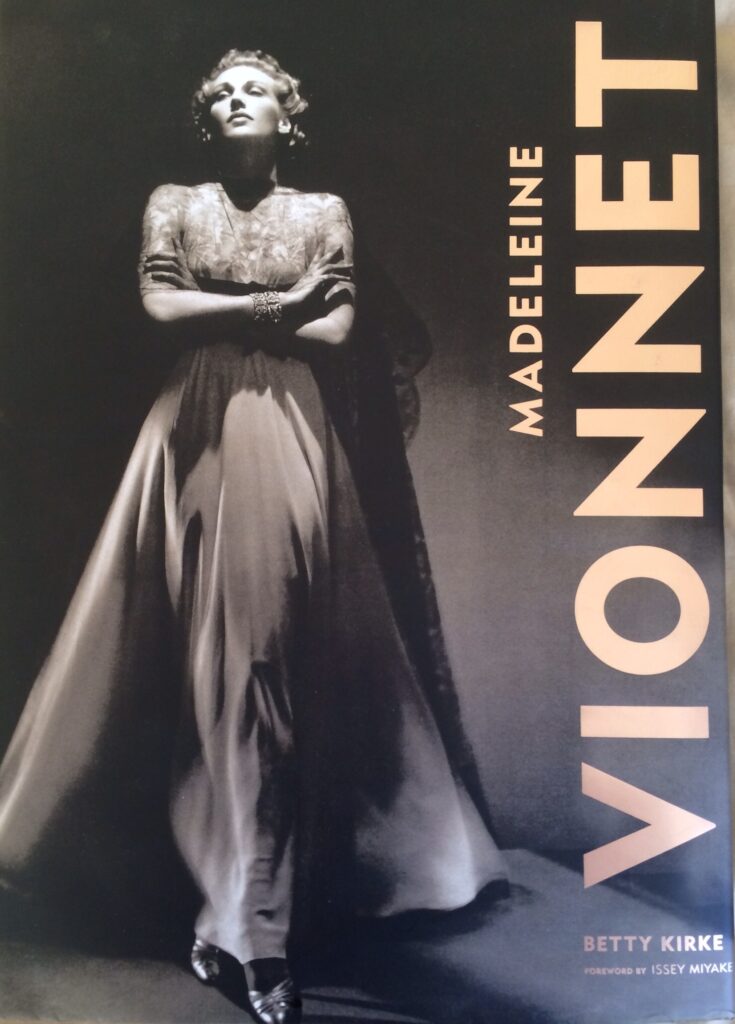
photo/jetsetswing
Notable Collections and Work
Vionnet’s work is filled with standout collections that shaped the world of haute couture. One of her most famous creations was the “Handkerchief Dress,” a flowing, lightweight garment crafted from layers of silk, creating an ethereal, floating effect as the wearer moved. It captured her love for simplicity and elegance, and it’s still celebrated today for its perfect harmony between form and movement.
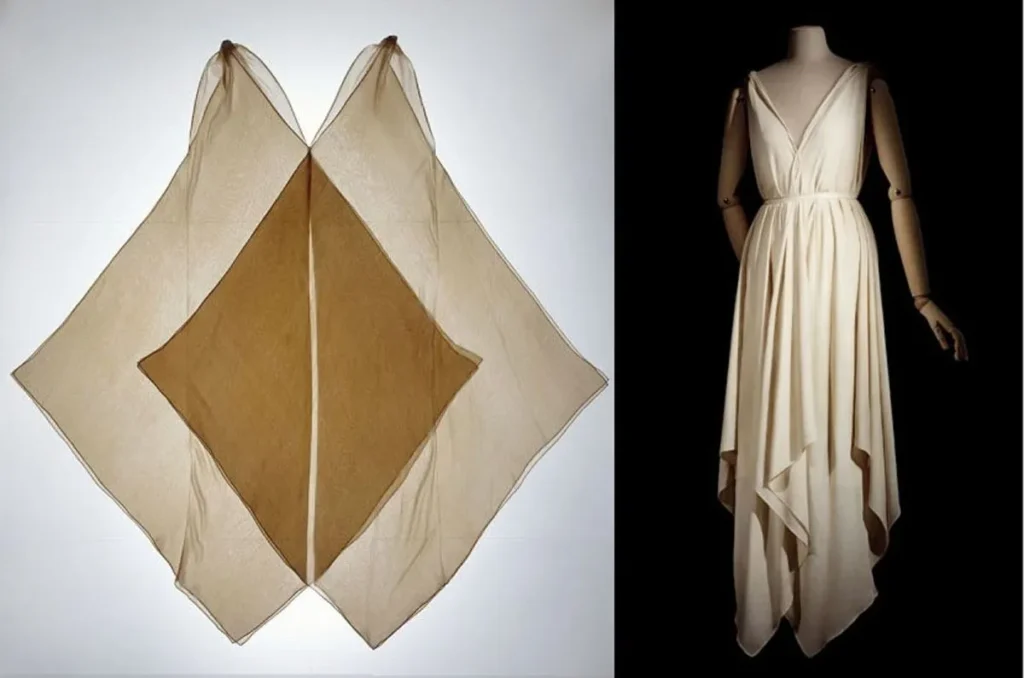
photo/pinterest
Another iconic creation was the “Cowl Neck Gown,” which became a favorite among the elite. The gown featured the signature bias cut and draped in a way that enhanced the body’s natural shape. Vionnet’s gowns were synonymous with high society fashion, and her creations were often worn by the aristocracy and Hollywood stars alike.
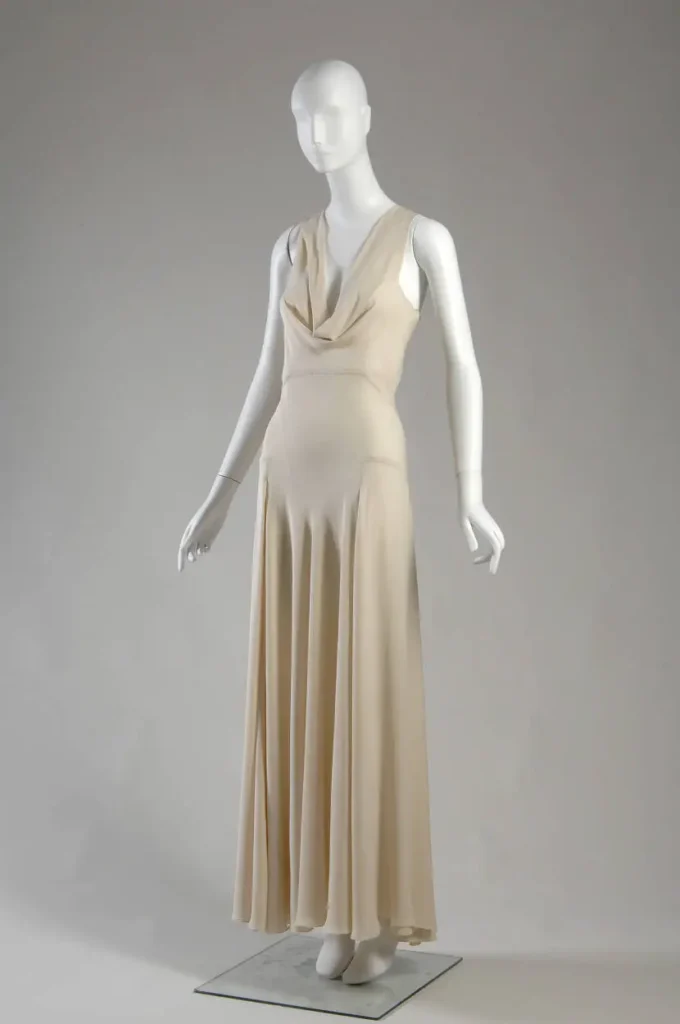
photo/carlidigitalcollection
Her “Grecian-Inspired Gowns” also gained widespread popularity. These designs reflected her admiration for classical Greek art, featuring draped fabric that mimicked the robes of ancient sculptures. These gowns were revolutionary for their time, as they highlighted freedom of movement and broke away from the restrictive styles of the early 20th century.
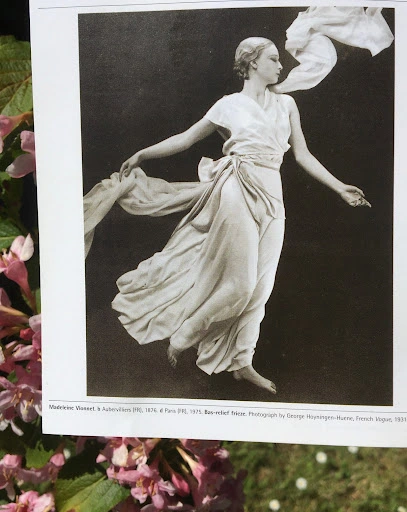
photo/huwrees
Through these collections, Vionnet established herself as a true visionary in the world of haute couture, leaving behind a legacy of elegance and innovation that continues to inspire modern designers.
Madeleine Vionnet’s Revolutionary Techniques
What set Madeleine Vionnet apart from her peers was her pioneering use of the bias cut. Instead of cutting fabric along the traditional straight grain, Vionnet began cutting her fabric on the diagonal. This seemingly simple change allowed her to create dresses that clung to the body in a way that no other garment had before. Her dresses flowed effortlessly, following the curves of the body rather than constraining them.
The Bias Cut: A Game Changer
The bias cut is perhapsMadeleine Vionnet’s most significant contribution to fashion. By cutting fabric at a 45-degree angle, Vionnet could achieve a more natural stretch and drape, which gave her designs an unprecedented fluidity. This technique revolutionized the way women’s clothing was made, allowing garments to move with the body rather than against it. The bias cut also eliminated the need for corsets and other restrictive undergarments, marking a move toward more liberating fashion for women.
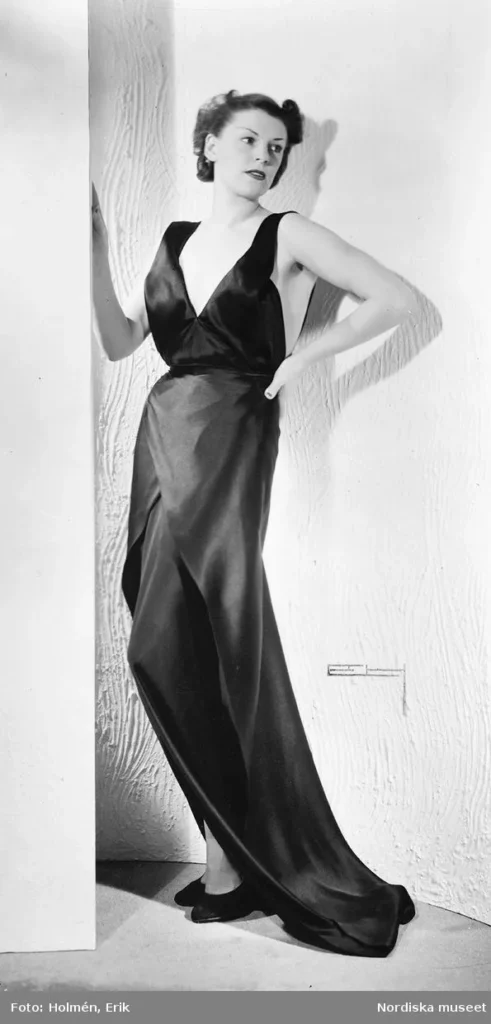
phooto/europeana
The Art of Draping
Vionnet wasn’t just about cutting fabric in innovative ways; she was also a master of draping. Her approach to fashion was more akin to a sculptor working with clay than a traditional designer. Instead of sketching out designs first, she would drape fabric directly onto mannequins, letting the material guide her creations. Her love for Grecian art was evident in this technique. Just like the ancient statues that depicted flowing, natural forms, her gowns seemed to defy gravity and embraced the body’s natural shape.
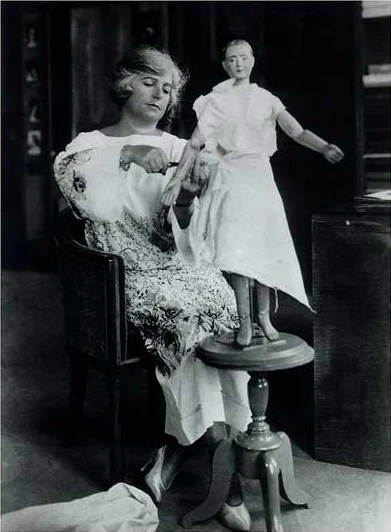
photo/patternedhistory
A Revolutionary Approach to the Female Body
At a time when corsets were still in vogue, Vionnet had the audacity to reject them altogether. She believed that women should not be confined by their clothing but should feel liberated by it. Her designs celebrated the natural curves and contours of the female body, making her one of the first designers to truly embrace body positivity.
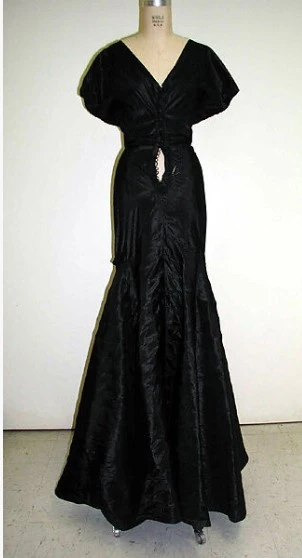
photo/metmuseum
Key Contributions to Fashion
Beyond the bias cut, Vionnet made countless contributions to fashion that are still in use today. She was a pioneer in minimalism, rejecting excessive adornments in favor of simple yet striking designs. She also revolutionized evening wear, creating dresses that moved beautifully and embraced a woman’s natural silhouette. One of her most iconic designs, the “handkerchief dress,” featured flowing layers of fabric that seemed to float with every step.
Vionnet’s Signature Designs
Her evening gowns were the epitome of luxury and sophistication, crafted from silk, chiffon, and velvet. These gowns were loved by celebrities and aristocrats alike, becoming symbols of elegance. Many of her designs were inspired by the classical world, with influences from Greek art, emphasizing natural forms and freedom of movement. This set her apart from other designers, whose works often prioritized form over function.
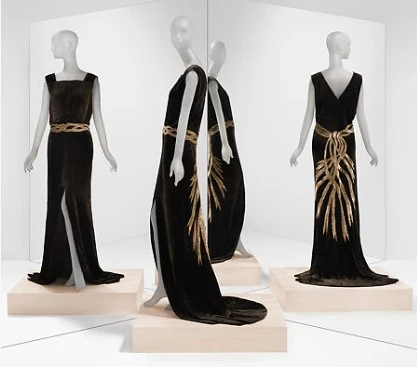
photo/metmuseum
Also read-Jeanne Paquin: The Pioneer of Modern Fashion
The Influence of Greek Art and Sculpture
It’s impossible to talk about Vionnet’s work without mentioning her love for Greek art. She was deeply inspired by the draped garments seen in ancient Greek sculptures, and this influence is apparent in almost all her creations. Much like the flowing robes of Greek goddesses, her gowns had a sense of ease and grace, perfectly highlighting the natural beauty of the body.
Minimalism and Modernity in Vionnet’s Designs
While many designers of the early 20th century still favored elaborate, structured garments, Vionnet championed a minimalist approach. Her designs were often devoid of excessive ornamentation, focusing instead on clean lines and simple, elegant silhouettes. This minimalist aesthetic mirrored the broader cultural shift towards modernity in the post-World War I era. Women were seeking clothing that allowed for freedom and comfort, and Vionnet’s designs offered exactly that.
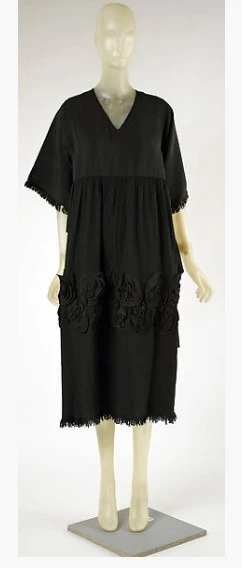
photo/metmuseum
Vionnet’s Philosophical Approach to Fashion
Vionnet’s philosophy was rooted in the idea that clothing should be an extension of the body, not something that contorted or distorted it. She believed deeply in creating garments that allowed for freedom of movement, a concept inspired by her admiration for classical Greek art. Much like the flowing robes depicted in ancient statues, Vionnet’s dresses celebrated the natural beauty of the human form.
Innovations in Fabric and Techniques
Vionnet’s genius wasn’t limited to the bias cut. She also pioneered the use of fabrics like silk, satin, and crepe, materials that complemented her designs and enhanced the fluidity of her garments. Her work with these materials helped to elevate the standard of couture, showing that luxurious fabrics could be used in innovative and unexpected ways.
Celebrity Endorsements and Cultural Impact
It wasn’t long before Vionnet’s designs became popular with the elite. Her clients included Hollywood stars like Marlene Dietrich and Katharine Hepburn, who were drawn to her elegant, feminine creations. The sleek, glamorous aesthetic of Vionnet’s designs was perfect for the burgeoning world of cinema, and her dresses became synonymous with Hollywood glamour during the 1930s.
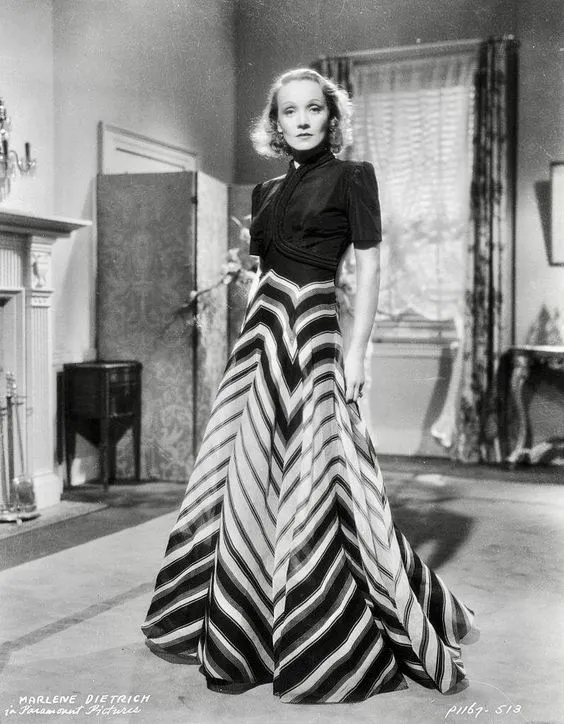
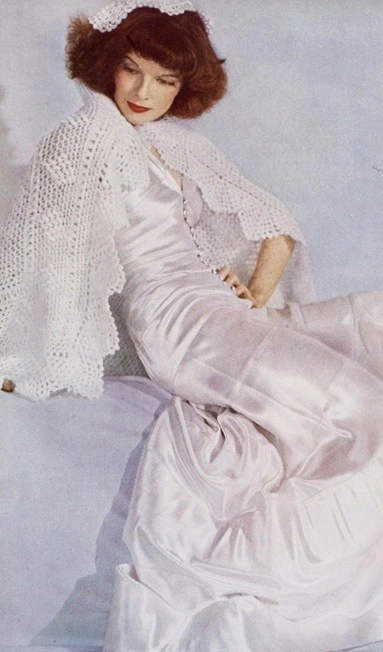
Marlene Dietrich(left)/photo/pinterest Katharine Hepburn(right)/photo/tumblr
Establishment of the Vionnet Fashion House
In 1912, Vionnet established her own fashion house, Maison Vionnet. However, her ascent to success was not immediate. The outbreak of World War I forced her to close her fashion house temporarily. When she reopened it in 1919, her designs quickly gained popularity, and she became known for creating some of the most innovative garments of her era.
The Fall of Maison Vionnet
Despite her success, Vionnet’s fashion house eventually faced challenges. The outbreak of World War II and the changing fashion landscape led to the closure of Maison Vionnet in 1939. Vionnet herself chose to retire from fashion, leaving behind a legacy that would only be fully appreciated in the years to come.
Vionnet’s Influence on Modern Designers
Even though she passed away in 1975, Madeleine Vionnet’s influence lives on. Many of today’s top designers, such as Azzedine Alaïa and John Galliano, have cited her as a major inspiration. Her innovative techniques, especially the bias cut, continue to be used in fashion houses around the world.
Vionnet’s Legacy
Madeleine Vionnet’s influence on modern fashion is undeniable. Designers like John Galliano, Azzedine Alaïa, and Vivienne Westwood have all cited her as a key influence. Her mastery of form, fabric, and technique continues to inspire contemporary designers who seek to create clothing that is both beautiful and functional.
Revival of the Vionnet Brand
In the early 21st century, the Vionnet brand was revived by a new generation of designers who sought to honor her legacy. The brand’s relaunch brought Vionnet’s timeless designs back into the spotlight, with collections that paid tribute to her pioneering work in fashion. While the brand has evolved, it remains rooted in the principles that Madeleine Vionnet held dear: craftsmanship, innovation, and a deep respect for the female form.
Conclusion
Madeleine Vionnet may not have achieved the same level of fame as some of her contemporaries, but her contributions to fashion are immeasurable. Her innovative techniques, particularly the bias cut, revolutionized the way women’s clothing was designed and worn. Vionnet’s work not only liberated women from the constraints of rigid, structured garments but also paved the way for modern fashion as we know it today.
FAQs
1. What was Madeleine Vionnet’s most significant contribution to fashion?
Her introduction of the bias cut, which revolutionized the way garments were designed to enhance the natural form.
2. How did Madeleine Vionnet revolutionize women’s clothing?
By rejecting rigid, structured designs in favor of fluid, free-flowing garments that moved with the body, enhancing comfort and grace.
3. Why is the bias cut so important in fashion?
The bias cut allows for greater flexibility and draping, resulting in clothing that contours the body naturally and provides a sleek, elegant silhouette.
4. What materials did Vionnet prefer for her designs?
Vionnet favored luxurious fabrics like silk, satin, and crepe, which complemented her flowing, minimalist designs.
5. Who are some modern designers influenced by Madeleine Vionnet?
Designers like John Galliano, Azzedine Alaïa, and Vivienne Westwood have all drawn inspiration from Vionnet’s groundbreaking techniques.
One thought on “Madeleine Vionnet: The Architect of Modern Fashion”